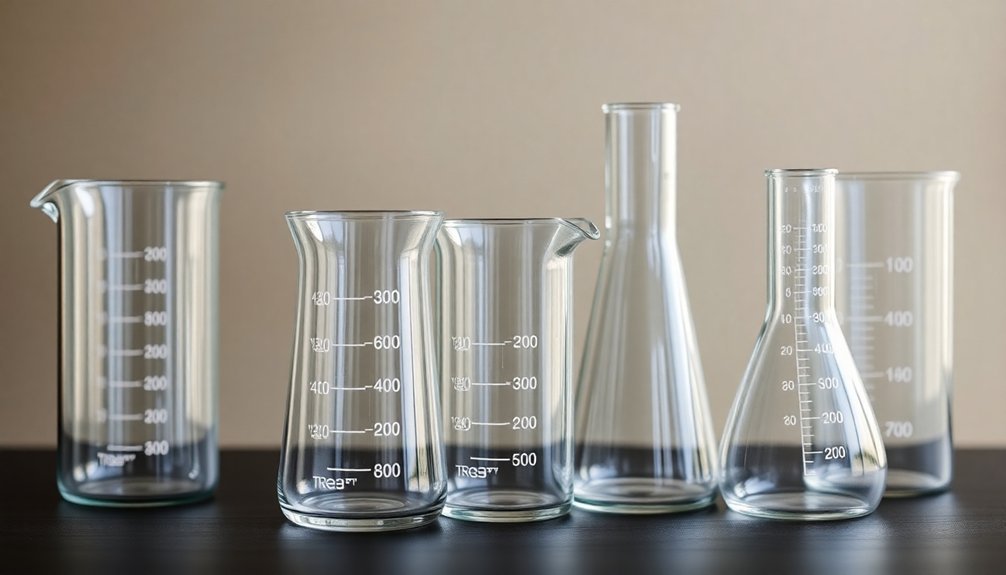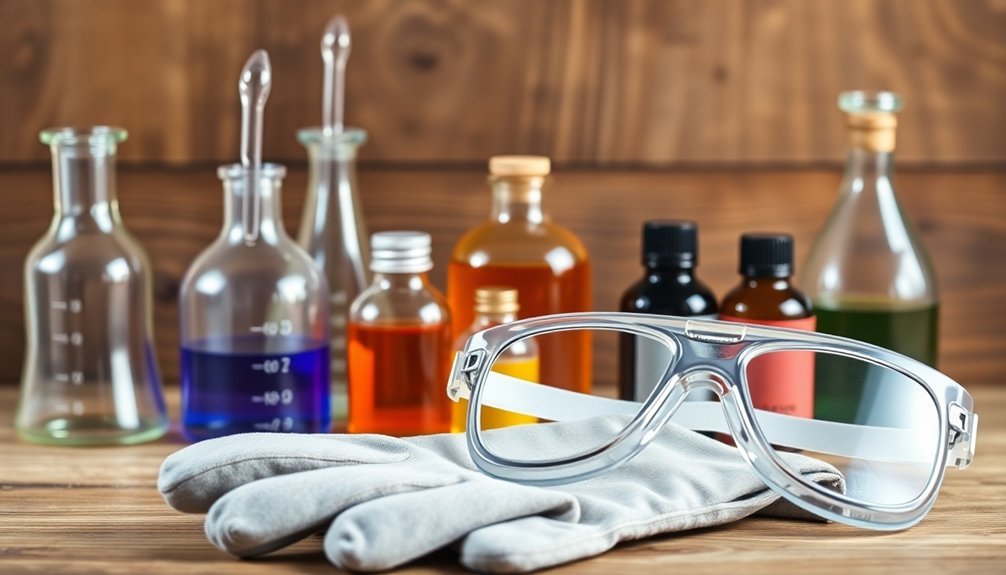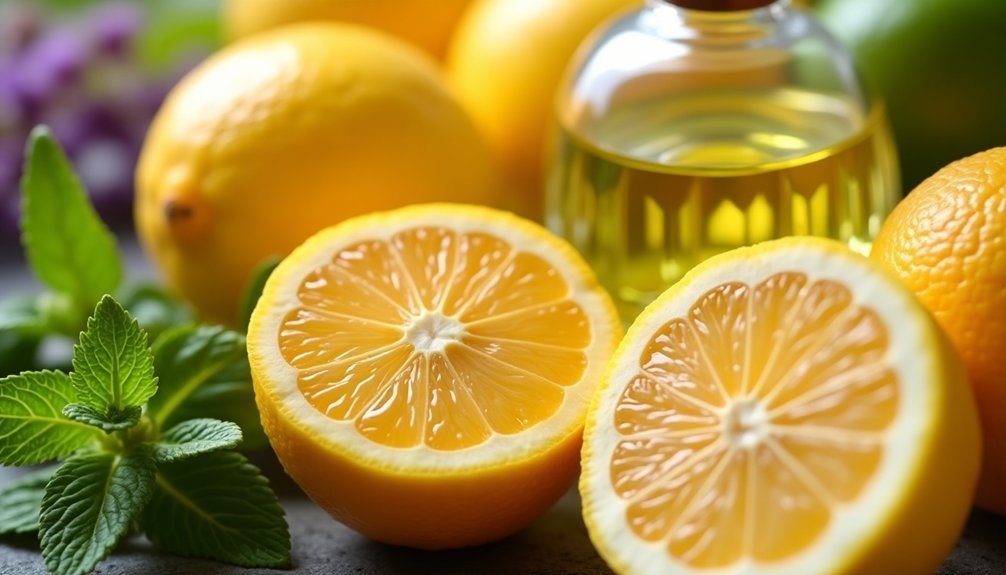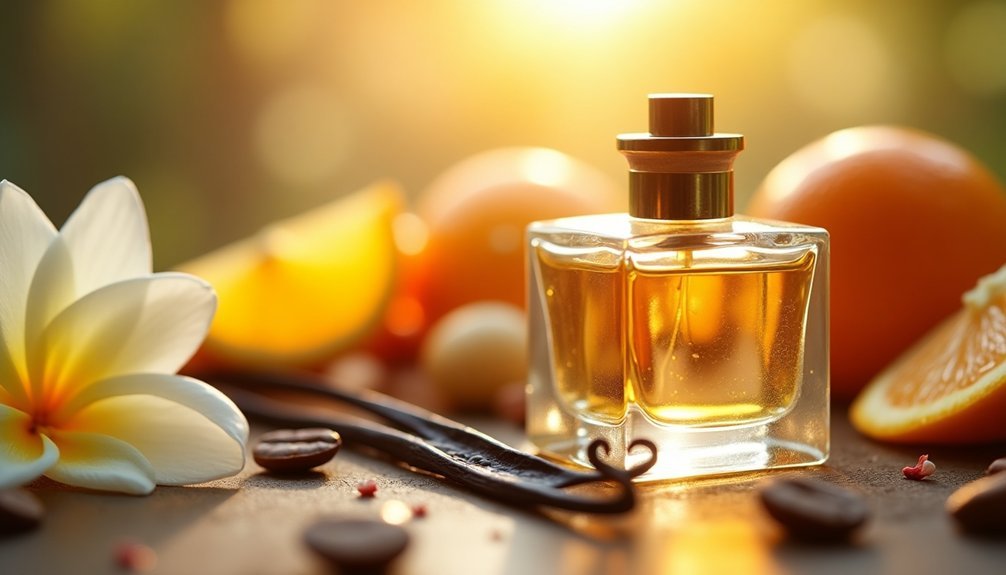You'll need five essential tools to start your perfume-making journey: borosilicate glass beakers for mixing, a precise digital scale (accurate to 0.01g) for measuring ingredients, protective gear like nitrile gloves and safety goggles, small glass bottles with secure labels for storing your creations, and disposable pipettes for transferring liquids without contamination. These fundamental tools will set you up for success, and there's much more to discover about each one's specific uses and benefits.
Essential Glass Beakers and Cylinders for Precise Measurements

When starting your perfume-making journey, you'll need high-quality glass beakers and cylinders as your foundation tools.
Choose borosilicate glass beakers for their durability and resistance to temperature changes, with sizes ranging from 25-50ml for standard measurements and 100-250ml for larger batches.
You'll want to pair these with precise glass measuring cylinders to guarantee accurate volume measurements, especially when following specific recipes.
Keep your glassware clean by washing with soapy water and sterilizing with ethanol before and after use.
Don't forget to wear protective gloves and safety glasses when handling these tools.
Adding a thermometer for temperature is crucial when working with recipes that require specific heat levels.
Store your beakers and cylinders safely to prevent breakage, and regularly inspect them for damage.
Replace any worn-out pieces to maintain accuracy in your perfume-making process.
Digital Scale: Your Foundation for Accurate Formulations
Beyond your glassware collection, a high-quality digital scale forms the backbone of successful perfume making. You'll need precision down to 0.01g or even 0.001g to guarantee consistent formulations, as measuring by drops can be unreliable due to varying material densities. With a price point of US$29.95 per scale, these tools offer an affordable entry point for aspiring perfumers.
| Feature | Why It Matters |
|---|---|
| Tare Function | Lets you zero out container weights |
| Multiple Units | Flexibility in following recipes |
| Auto-Off | Preserves battery life |
For beginners, a mini digital scale weighing up to 100g will serve you well. Look for models with illuminated displays and protective covers for durability. While professional lab balances offer higher precision, they're notably more expensive. Your scale should include essential features like calibration capabilities and multiple measurement units. Consider investing in accessories like windshields to enhance accuracy during weighing.
Protective Gear: Safety First in DIY Perfumery

Safety in perfume making demands proper protective gear to shield you from potential hazards. When you're working with essential oils and chemical compounds, you'll need to protect yourself from spills, fumes, and skin contact. Since natural perfume ingredients are safer than commercial options, you may be tempted to skip protection – but don't.
Essential protective items you'll need:
- Nitrile or latex gloves to prevent skin irritation from raw materials
- Safety goggles to protect your eyes from accidental splashes
- A lab coat or apron to keep your clothes clean and protected
- A mask or respirator to avoid inhaling strong fumes
- Protective covers for your work surface to prevent stains
Don't skip on safety equipment, even for small projects. You'll want to guarantee you're fully protected before handling any perfume ingredients.
Remember to check the safety data sheets for specific materials you're using, as some may require additional protective measures.
Small Glass Bottles and Labels for Testing
Small glass bottles and proper labeling form the backbone of fragrance testing and development. You'll need a variety of sizes, from 1-2 mL sample vials to 30 mL bottles, all crafted from high-quality glass that protects your precious creations from degradation and chemical interactions.
| Size | Best Use | Material |
|---|---|---|
| 1-2 mL | Initial testing | Clear flint glass |
| 5-10 mL | Travel samples | Amber glass |
| 15-30 mL | Small batches | Frosted glass |
Don't forget to establish a consistent labeling system for your bottles. Include essential details like fragrance name, concentration, and creation date on each label. Your labels should be durable and securely attached to prevent mix-ups. This organized approach will help you track your experiments and replicate successful formulations with precision.
Pipettes and Droppers: The Art of Transfer

Precise measurements form the foundation of successful perfume making, and pipettes and droppers are your essential tools for achieving this accuracy.
You'll find plastic pipettes are your best choice as a beginner, offering disposable convenience at around $0.12 per unit while holding approximately 3ml of liquid.
- Use a new pipette for each fragrance to prevent cross-contamination
- Squeeze the bulb, insert into liquid, and release to fill to desired amount
- Check measurement lines carefully for accurate dispensing
- Don't tie pipettes to bottles with elastic bands
- Replace rather than reuse to maintain product integrity
While glass pipettes are reusable, they're not recommended for frequent use due to contamination risks and breakage.
Your plastic pipettes will serve you well, especially when transferring essential oils, fragrances, and other liquid ingredients with precision and safety.
Frequently Asked Questions
How Long Can Fragrance Blotters Be Stored Before They Lose Effectiveness?
You'll find your fragrance blotters stay effective for several weeks to months when stored in airtight containers away from light and moisture. Keep them in a cool, dry place for ideal preservation.
What Temperature Range Should Perfume Ingredients Typically Be Stored At?
You'll want to store your perfume ingredients between 55-65°F (13-18°C). You can also maintain them at 60-70°F (15-21°C). Either range works well to preserve your fragrances' quality and chemical stability.
Can Magnetic Stirrers Affect the Chemical Composition of Certain Fragrance Ingredients?
No, your magnetic stirrer won't alter the chemical composition of fragrance ingredients. It simply helps mix them thoroughly. You can safely use it without worrying about changing the molecular structure of your perfume components.
How Often Should Digital Scales Be Recalibrated for Accurate Perfume Measurements?
You'll need to calibrate your digital scale monthly, after moving it, or before starting new perfume projects. Don't forget to recalibrate if the scale's been dropped or stored for long periods.
Which Cleaning Solutions Are Safe for Sanitizing Perfumery Equipment Between Uses?
You'll want to use free-rinsing detergents without fragrances or additives. They're safe for glass and steel equipment, won't leave residue, and are biodegradable. Low-foaming alkaline cleaners work well for tough residues.
In Summary
Now you're ready to begin your perfume-making journey! With these five essential tools, you'll have everything needed to start creating your signature scents safely and precisely. Don't forget to label all your creations and keep detailed notes of your formulations. Once you've mastered using these basic tools, you can expand your collection and experiment with more advanced perfumery equipment.





Leave a Reply